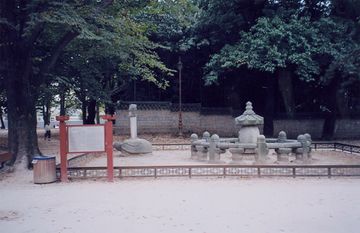예종대왕 태실 및 비
| 예종대왕태실및비 Placenta Chamber and Stele of King Yejong |
|
 예종대왕 태실 및 비, 국가문화유산포털, 문화재청. |
|
| 대표명칭 | 예종대왕태실및비 |
|---|---|
| 영문명칭 | Placenta Chamber and Stele of King Yejong |
| 한자 | 睿宗大王胎室및碑 |
| 주소 | 전라북도 전주시 완산구 태조로 44 (풍남동3가, 전주사고) |
| 지정(등록) 종목 | 전라북도 민속문화재 제26호 |
| 지정(등록)일 | 1986년 9월 8일 |
| 분류 | 유적건조물/인물사건/인물기념/탄생지 |
| 수량/면적 | 일괄 |
| 웹사이트 | 예종대왕 태실 및 비, 국가문화유산포털, 문화재청. |
|
|
|
해설문
국문
왕가에서는 아이가 태어나면 그 태*를 태항아리에 담아 석실에 묻었는데, 이를 태실이라 한다. 이곳은 조선 8대 임금인 예종의 태를 묻은 태실과 태실비이다. 원래 완주군 구이면 원덕리 태실 마을 뒷산에 있었다. 1928년 일제강점기 조선총독부가 전국에 있는 태실의 태항아리를 서울로 가져가면서 태실들이 훼손되었는데, 예종의 태실도 이때 훼손되었다. 이후 태실은 구이초등학교 북쪽(편)에 옮겼다가, 1970년에 경기전으로 옮겨왔다.
비석은 태실과 함께 옮긴 것으로, 앞면에는 ‘예종대왕태실(睿宗大王胎室)’이 새겨져 있고 뒷면에는 선조 11년(1578)에 처음 비를 세운 후, 영조 10년(1734)에 다시 세웠다고 기록하고 있다.
태를 담았던 내항아리와 지석**은 국립고궁박물관에, 내항아리를 담은 외항아리는 국립중앙박물관에 소장되어 있다.
- 태(胎) : 태반과 탯줄
- 지석(誌石) : 태 주인의 이름과 생년월일 등을 기록하여 묻은 돌판
영문
Placenta Chamber and Stele of King Yejong
This is the site of the placenta chamber of King Yejong (1450-1469, r. 1468-1469).
A placenta chamber is where a nested jar containing a royal baby's placenta and umbilical cord were enshrined. During the Joseon dynasty (1392-1910), a newborn baby's placenta was regarded as the origin of life, and preserving it would ensure a healthy, advantageous life for the child. Because this was especially important to the royal family, they took great effort to find the most auspicious place and time to build a placenta chamber. This ritual of placenta chamber construction is unique to Korea.
King Yejong’s placenta was originally enshrined behind a mountain in Wondeok-ri Village of Wanju. During the Japanese colonial period (1910-1945), the Japanese authorities relocated most of the Joseon royal family's placenta jars and destroyed the chambers. The placenta chamber of King Yejong was destroyed as well. In 1970, King Yejong’s placenta chamber was relocated to Gyeonggijeon Shrine.
The stele was first erected in 1578 and then re-erected in 1734. The front of the stele has an inscription that reads “Placenta Chamber of the Great King Yejong." The stele was relocated together with the placenta chamber.
The inner placenta jar and the stone plates on which the newborn baby’s name, date of birth, and other information were recorded, are currently kept in the National Palace Museum of Korea. The outer placenta jar is now kept in the National Museum of Korea.
영문 해설 내용
이곳은 예종(재위 1468-1469)의 태실이다.
태실은 왕실에서 자녀의 태(胎)를 봉안한 태항아리를 모신 석실이다. 조선시대에 태는 생명의 근원으로 여겨졌고, 태를 잘 보존하면 자녀의 건강을 보장할 수 있다고 믿었다. 특히 조선 왕실에서는 명당을 물색하고 길일을 가려 태를 봉안하였다. 태실을 세우는 이러한 의식은 한국에 유일하다.
예종의 태는 원래 완주군 구이면 원덕리 마을 뒷산에 봉안되었다. 일제강점기 때 일본은 조선왕조의 태실들을 훼손하고 태항아리를 다른 곳으로 옮겼다. 예종의 태실 역시 이때 훼손되었고, 1970년에 경기전으로 옮겼다.
비석은 태실과 함께 옮긴 것으로, 1578년에 처음 세운 후 1734년에 다시 세웠다고 한다. 앞면에는 ‘예종대왕 태실’이라고 새겨져 있다.
태 주인의 이름과 생년월일 등을 기록한 돌판과 태를 담았던 내항아리는 국립고궁박물관에 소장되어 있고, 내항아리를 담았던 외항아리는 국립중앙박물관에 소장되어 있다.